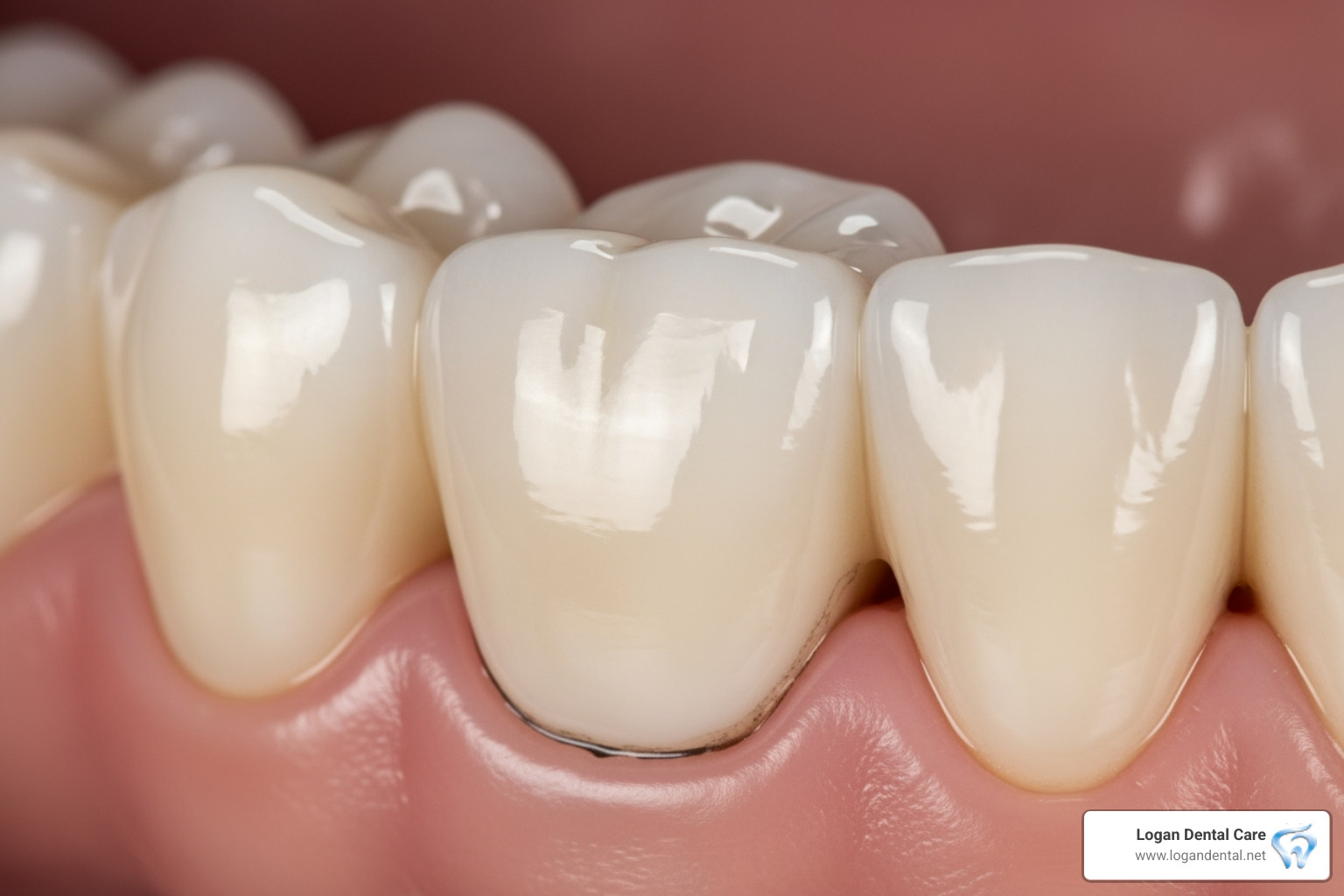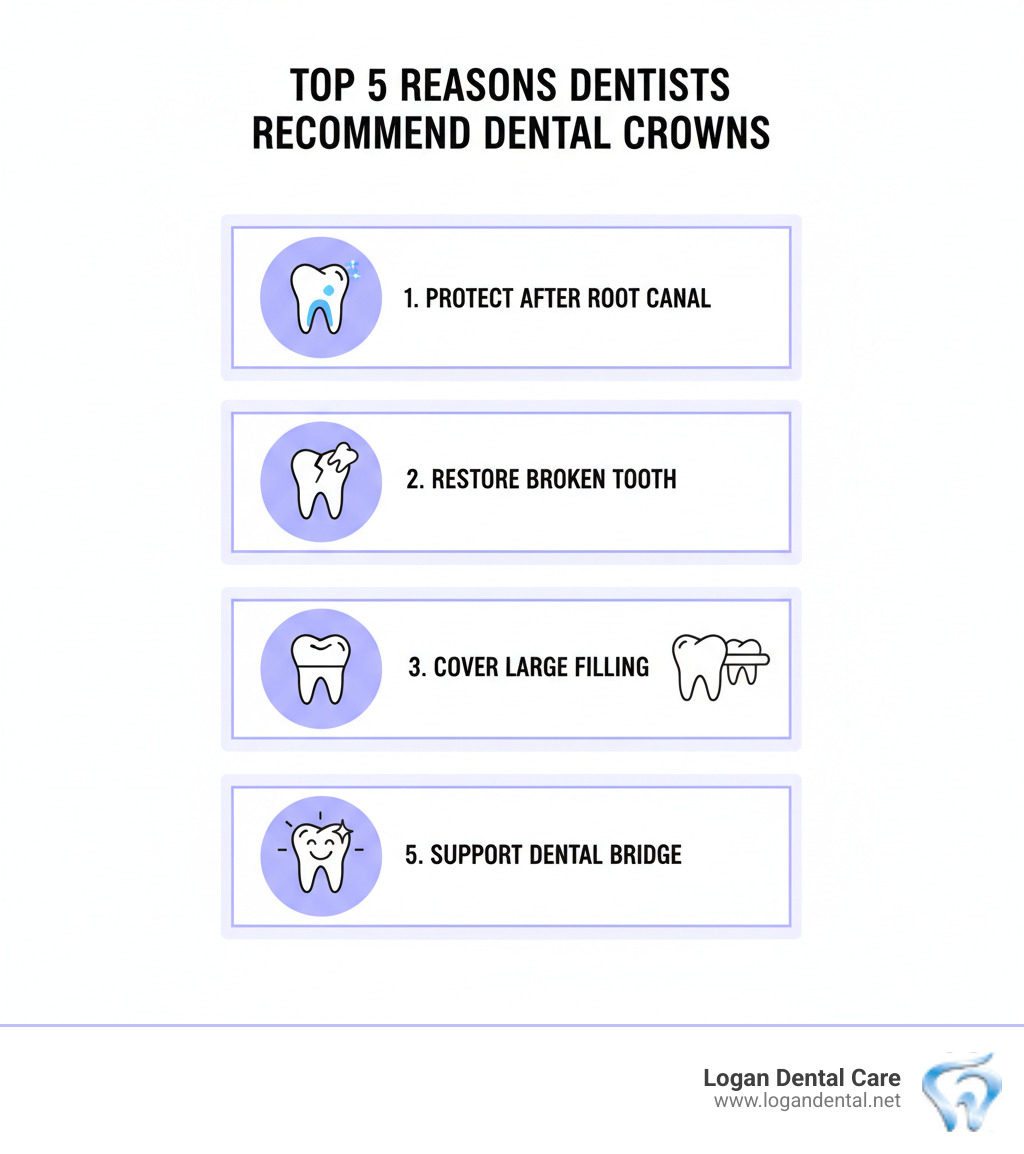From Porcelain to PFM: Navigating Your Dental Crown Choices

Understanding Your Dental Crown Choices
Navigating dental crown options can feel overwhelming. If you're looking for a quick answer, here are the main types of crowns available today:
Main Types of Dental Crowns:
- Porcelain/Ceramic - Best for front teeth, natural appearance.
- Porcelain-Fused-to-Metal (PFM) - A balance of strength and aesthetics.
- Zirconia - Very strong with a natural look, works for all teeth.
- Gold/Metal Alloy - The most durable, ideal for back teeth.
- E-Max (Lithium Disilicate) - A strong and highly aesthetic ceramic option.
- Resin - A budget-friendly temporary solution.
A dental crown is a tooth-shaped cap that fits over a damaged tooth to restore its shape, strength, and appearance. You might need a crown for a broken tooth, a tooth that's had a root canal, or to support a large filling. According to the American Dental Association, crowns can last between 5 and 15 years, and with proper care, some last 30 years or more.
The challenge isn't whether you need a crown—it's which type makes sense for your situation. In this guide, we'll break down each option so you can have a confident conversation with your dentist at Logan Dental Care in Bellefontaine, OH.

A Deep Dive into Your Dental Crown Options
Let's explore your dental crown options in detail, covering materials, procedures, and costs so you can feel prepared for your appointment.
Comparing Materials: Your Primary Dental Crown Options
Choosing the right material depends on the tooth's location, your budget, and your lifestyle. Each has unique strengths.
Here's how the main dental crown options stack up:
| Material Type | Aesthetics | Durability | Cost Range (USD) | Best Use |
|---|---|---|---|---|
| All-Porcelain/All-Ceramic | Excellent (natural translucency) | Good (prone to chipping, less durable than metal) | $800-$3,000 | Front Teeth (high aesthetic) |
| Porcelain-Fused-to-Metal (PFM) | Good (can show dark line at gumline) | Very Good (stronger than all-porcelain) | $500-$2,000 | Front or Back Teeth (versatile) |
| Zirconia | Excellent (natural, opaque) | Excellent (very strong, resistant to wear) | $1,200-$2,500 | Front or Back Teeth (all-around) |
| Gold & Metal Alloy | Poor (metallic appearance) | Superior (most durable, minimal wear on opposing teeth) | $600-$2,500 | Back Teeth (high chewing force) |
| E-Max (Lithium Disilicate) | Excellent (highly aesthetic, translucent) | Excellent (stronger than traditional porcelain) | $800-$3,000 | Front or Back Teeth (balanced) |
| Resin | Fair (less natural, prone to staining) | Poor (least durable, wears down faster) | $400-$600 | Temporary or Pediatric (budget-friendly) |
All-Porcelain/All-Ceramic Crowns
Ideal for front teeth due to their natural, translucent appearance that mimics real tooth enamel. They are highly biocompatible but can be more prone to chipping than metal or zirconia. For more on these, see our guide on ceramic teeth caps.
Porcelain-Fused-to-Metal (PFM) Crowns
PFM crowns are a classic choice, balancing strength and aesthetics. They have a metal core for durability with a porcelain exterior. A potential downside is a dark line appearing at the gumline over time.
Zirconia Crowns
A modern, high-tech ceramic that combines incredible strength with a natural look. It's suitable for both front and back teeth and is very durable, though it's a higher-cost option.
Gold & Metal Alloy Crowns
The most durable option, ideal for back molars that handle heavy chewing forces. They rarely chip or break and require less tooth removal, but their metallic appearance makes them unsuitable for visible teeth.
E-Max Crowns
A premium type of all-ceramic crown made from lithium disilicate. It offers excellent aesthetics and is stronger than traditional porcelain, making it a great choice for visible teeth.
Resin Crowns
The most affordable option, often used for temporary crowns or pediatric cases. Resin is less durable, wears down faster, and is more prone to staining than other materials.
For a broader understanding of different crown materials, the Canadian Dental Association offers an overview of crown types.
The Dental Crown Procedure: What to Expect
Getting a dental crown at Logan Dental Care typically requires two visits.

The Two-Visit Process
During the first visit, we numb the area, prepare the tooth by removing decay and reshaping it, and then take an impression. This impression is sent to a dental lab to create your custom crown. We'll place a temporary crown to protect your tooth while you wait.
At your second visit, we remove the temporary crown and check the fit and appearance of your new permanent one. After making any necessary adjustments to ensure a perfect bite and look, we permanently cement the crown in place, completing the restoration. If your crown follows a root canal, we ensure everything works together seamlessly. Learn more in our guide to root canals and crowns.
Front vs. Back Teeth: Specialized Dental Crown Options
The location of the tooth is key. Front teeth require superior aesthetics, making all-porcelain, E-Max, or zirconia ideal choices because they look the most natural. Back teeth (molars) need maximum durability to handle chewing forces, so zirconia and gold alloy are excellent options. PFM crowns offer a versatile balance for either location.
Same-Day Crowns: A Modern Choice
What if you could get a permanent crown in a single visit? With modern CAD/CAM technology, you can.

How Same-Day Crowns Work
Systems like CEREC allow us to design and create your crown right in our office. We use a digital scanner to create a 3D image of your tooth, design the crown on a computer, and mill it from a ceramic block while you wait. This single-visit restoration offers incredible convenience, eliminating the need for a temporary crown and a second appointment. However, this option may have a higher cost and is not suitable for all cases.
Cost of Dental Crowns and Insurance
Understanding the cost of dental crown options is crucial. The price varies by material, with resin being the most affordable ($400-$600) and high-end options like zirconia and E-Max costing more ($1,200-$3,000). PFM and gold crowns fall in between. Most dental insurance plans provide coverage for medically necessary crowns, typically paying 50% of the cost after your deductible. Our team at Logan Dental Care can help you understand your benefits and provide a precise cost estimate. For more details, see our guides on dental crown costs and dental cap costs.
Crowns vs. Other Restorations
Sometimes, a different restoration is a better fit.
Veneers are thin, cosmetic shells that cover only the front of a tooth to improve its appearance. Crowns are restorative, covering the entire tooth to provide structural support and protection.
For smaller areas of decay, a filling is sufficient. When damage is too large for a filling but doesn't require a full crown, an inlay or onlay (partial crown) is used. A full crown is necessary when a tooth is severely damaged, cracked, or has had a root canal, as it provides the comprehensive strength needed for long-term function.
Living With Your Crown: Longevity, Care, and Making Your Choice
Once your new crown is in place, proper care is key to ensuring it lasts for many years.
Lifespan and Care of Crowns
Most crowns last between 5 and 15 years, but with excellent care, they can last 30 years or more. The material and your oral habits are key factors. To maximize your crown's lifespan:
- Brush and Floss Daily: Pay special attention to the area where the crown meets the gumline to prevent plaque buildup.
- Avoid Hard and Sticky Foods: Don't chew on ice, hard candy, or very sticky foods that could damage or dislodge your crown.
- Schedule Regular Check-ups: Visiting Logan Dental Care for routine exams allows us to monitor your crown and address any potential issues early.
Potential Risks
While crowns are very safe, it's good to be aware of potential issues. Contact us if you experience any of the following:
- Sensitivity: Some temporary sensitivity to hot or cold is normal, but let us know if it persists.
- Chipped Crown: Porcelain crowns can sometimes chip. Small chips can often be repaired.
- Loose Crown: If your crown feels loose, contact us immediately to have it re-cemented and prevent underlying decay.
- Allergic Reaction: This is rare but can occur with metal alloys. We offer metal-free options like zirconia and ceramic.
- Decay: The underlying tooth can still get a cavity at the crown's margin, making good hygiene essential.
Making the Final Decision with Your Dentist
Choosing among the various dental crown options is a decision you'll make with your dentist. At Logan Dental Care, we serve families in Bellefontaine and Logan County with a unique blend of small-town care and advanced technology. We'll discuss your needs, budget, and goals to help you select the perfect crown for your smile.
Ready to restore your smile and protect your teeth? Learn more about our Crowns and Bridges services and schedule a consultation with our team today. Let's work together to find the perfect solution for you.

